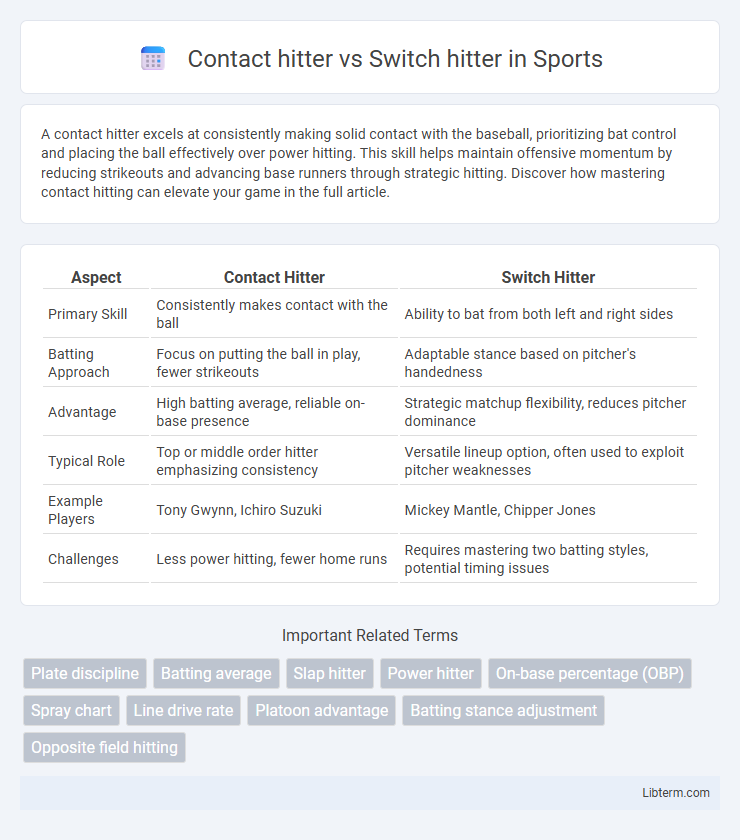A contact hitter excels at consistently making solid contact with the baseball, prioritizing bat control and placing the ball effectively over power hitting. This skill helps maintain offensive momentum by reducing strikeouts and advancing base runners through strategic hitting. Discover how mastering contact hitting can elevate your game in the full article.
Table of Comparison
| Aspect | Contact Hitter | Switch Hitter |
|---|---|---|
| Primary Skill | Consistently makes contact with the ball | Ability to bat from both left and right sides |
| Batting Approach | Focus on putting the ball in play, fewer strikeouts | Adaptable stance based on pitcher's handedness |
| Advantage | High batting average, reliable on-base presence | Strategic matchup flexibility, reduces pitcher dominance |
| Typical Role | Top or middle order hitter emphasizing consistency | Versatile lineup option, often used to exploit pitcher weaknesses |
| Example Players | Tony Gwynn, Ichiro Suzuki | Mickey Mantle, Chipper Jones |
| Challenges | Less power hitting, fewer home runs | Requires mastering two batting styles, potential timing issues |
Introduction to Contact Hitters and Switch Hitters
Contact hitters excel at making consistent, precise contact with the baseball, prioritizing bat control and high batting averages over power. Switch hitters possess the unique ability to bat both left-handed and right-handed, maximizing strategic advantages against pitchers of different handedness. Understanding the distinct skills of contact hitters and switch hitters highlights their complementary roles in baseball lineup optimization.
Defining Contact Hitters in Baseball
Contact hitters in baseball consistently make solid contact with the ball, focusing on bat control and placement rather than power. These players prioritize high batting averages by frequently putting the ball in play, reducing strikeouts and increasing opportunities for base hits. Unlike switch hitters who bat from both sides of the plate to exploit pitcher matchups, contact hitters often rely on precise timing and hand-eye coordination to consistently reach base.
Understanding Switch Hitters: Key Characteristics
Switch hitters possess the rare ability to bat proficiently from both left and right sides, offering strategic advantages against pitchers of varying handedness. Their adaptability enhances lineup flexibility and complicates pitching decisions, often leading to increased offensive consistency. Mastery of switch hitting demands exceptional hand-eye coordination, balanced stance mechanics, and rigorous training to maintain power and contact from both sides.
Core Differences: Contact Hitter vs Switch Hitter
A contact hitter specializes in consistently making ball-to-bat contact, prioritizing batting average and minimizing strikeouts, whereas a switch hitter has the ability to bat from both left and right sides of the plate to exploit pitcher matchups. The core difference lies in skill focus: contact hitters refine precision and timing to maximize on-base opportunities, while switch hitters emphasize versatility and strategic advantage against varying pitchers. Contact hitting emphasizes batting technique and hand-eye coordination, while switch hitting demands extensive practice and adaptability to maintain effectiveness from both batting stances.
Advantages of Being a Contact Hitter
A contact hitter excels in consistently putting the ball in play, increasing the likelihood of advancing runners and avoiding strikeouts, which benefits team offense by maintaining pressure on the defense. Their ability to make solid contact with pitches across the strike zone enhances batting average and on-base percentage, crucial metrics for offensive efficiency. Compared to switch hitters, contact hitters specialize in a consistent hitting approach, often resulting in fewer swings and misses and more productive at-bats.
Benefits of Switch Hitting in Modern Baseball
Switch hitting offers significant strategic advantages in modern baseball by allowing batters to maintain a favorable matchup against pitchers regardless of their throwing arm, increasing on-base percentages and overall offensive efficiency. This versatility reduces the impact of pitcher handedness, leading to more consistent at-bats and the potential to exploit defensive weaknesses. Teams benefit from increased lineup flexibility, enabling smoother in-game adjustments and improved run production.
Challenges Faced by Contact Hitters
Contact hitters face challenges such as maintaining a consistent bat speed and precise timing to connect effectively with various pitch types and speeds. They often encounter difficulty adjusting to power pitchers who rely on high velocity and movement, limiting the contact hitter's ability to make solid contact. Additionally, contact hitters must consistently read pitch location and spin to avoid weak contact or strikeouts, creating ongoing pressure to adapt to diverse pitching strategies.
Limitations and Difficulties for Switch Hitters
Switch hitters face significant challenges in maintaining equal proficiency from both sides of the plate, often struggling with timing and pitch recognition against pitchers of varying handedness. Their ability to generate consistent power and contact can be limited due to the complex mechanics required to master two distinct swings. Training demands are higher, and strategic adjustments during games can expose weaknesses, making it harder to achieve the reliability seen in specialized contact hitters.
Famous Contact Hitters and Switch Hitters in MLB History
Famous contact hitters in MLB history like Tony Gwynn and Wade Boggs are celebrated for their exceptional ability to consistently make solid contact, boasting high batting averages and low strikeout rates. Legendary switch hitters such as Mickey Mantle and Chipper Jones mastered batting from both sides of the plate, offering strategic advantages by adapting to pitchers' handedness. These players exemplify the distinct skills and tactical benefits of contact hitting and switch hitting, influencing team lineups and game strategies throughout baseball history.
Which Hitting Style Impacts Team Strategy More?
Contact hitters emphasize consistent ball contact to advance runners and maintain innings, influencing a team's ability to sustain rallies and manufacture runs. Switch hitters enhance lineup flexibility, allowing managers to optimize matchups against opposing pitchers and adjust batting order dynamically. The strategic value of switch hitters often outweighs that of contact hitters by providing versatile offensive options and complicating pitching decisions.
Contact hitter Infographic

 libterm.com
libterm.com